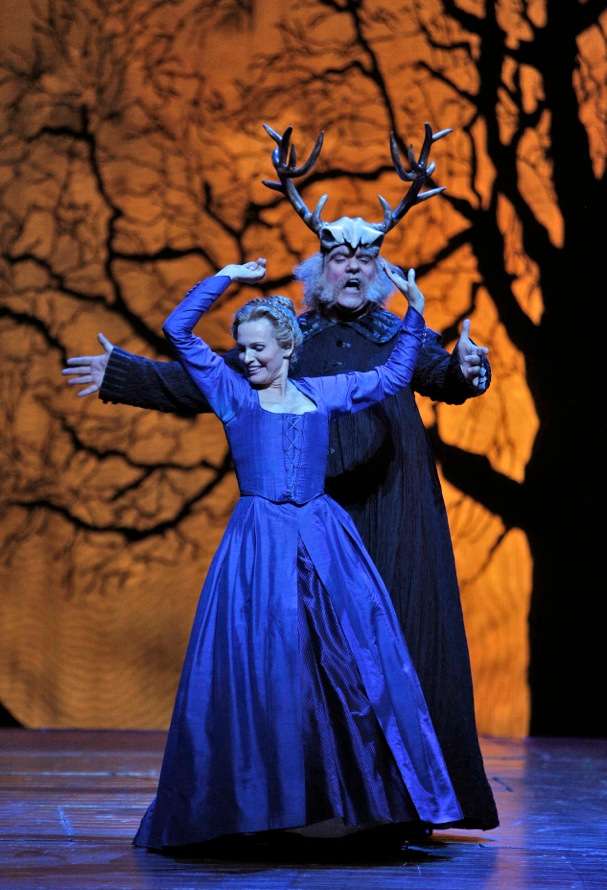|
Back
Fools rush in... San Francisco
War Memorial Opera House
10/08/2013 - & October 11*, 15, 20, 24, 27, 30, November 2, 2013
Giuseppe Verdi: Falstaff
Bryn Terfel (Falstaff), Ainhoa Arteta (Alice Ford), Heidi Stober (Nannetta), Meredith Arwady (Dame Quickly), Francesco Demuro (Fenton), Fabio Capitanucci (Ford), Renée Rapier (Meg Page), Greg Fedderly (Bardolfo), Joel Sorensen (Dr. Caius), Andrea Silvistrelli (Pistola)
San Francisco Opera Chorus, Ian Robertson (chorus master), San Francisco Opera Orchestra, Nicola Luisotti (conductor)
Olivier Tambosi (director), Frank Philipp Schlössmann (set designer), Christopher Verdosci (costume designer), Christine Binder (lighting designer), Gerd Mairandres (wig and makeup designer)

A. Arteta, B. Terfel (© Cory Weaver)
Of his 28 operas, Verdi wrote only two comedies and the first was a flop, following a series of devastating family tragedies and necessitating his fight for emotional survival. Verdi eventually resumed his vocation, but it is notable that his second comedy was his final operatic effort.
One can only imagine what it is like to be cast with bass-baritone Bryn Terfel, a voice of the century, performing one of his signature roles that has merged into a mosaic of the fictional character and the man. There are numerous marks of a master: just as an integrated personality possesses consistency, it retains plasticity to synthesize cumulative experience. Here, then, is Mr. Terfel's Falstaff – despite having absorbed the essence of the protagonist, characterization is always a work in progress. There is the challenge of projecting a sotto voce that is clearly heard by those in the uppermost balconies. How many can effectively toss off in a devil-may-care fashion some of the most difficult technical vocal requirements in the repertoire? When can one finally move across the stage as though it is one's natural environment, seemingly unaware that anyone is watching?
The sum of the performances in this exemplary cast is vastly greater than its parts. Soprano Ainhoa Arteta as feisty Alice Ford reveals a bright, shimmering sound with full but not excessive volume. Meg Page, Alice's equally mischievous friend, is masterfully interpreted by Renée Rapier as she successfully enlivens Meg's role, staying integral to the inner circle. Ms. Rapier's rich mezzo-soprano is uniquely colored with the hint of menace evoked by the women's conspiracies. Heidi Stober, with her luscious lyric coloratura soprano, unnecessarily modulates her complex voice as Alice's charming daughter Nannetta. In fact, Nannetta's innocent love for the ardent Fenton could be convincingly expressed as a coloratura, perhaps even as a soubrette.
And then there is Dame Quickly, deliciously portrayed by Meredith Arwady with her luscious contralto – a register seldom encountered and with even rarer availability of juicy characters. Ms. Arwady's perfectly-timed comic sensibility successfully juxtaposes Dame Quickly's simpler qualities with Falstaff's tragicomic persona. Her mimed obeisance when approaching Sir John is a highlight of the entire production.
One sympathizes with the male principals playing opposite Mr. Terfel's unrivaled genius – and yet each concentrates his individual strengths and to nicely hold his own.
Lyric tenor Fenton, Nannetta's lover, is sweetly evinced by Francesco Demuro, whose evolving skill gratifyingly reflects his maturing craft. Fabio Capitanucci, as Ford, contributes a sonorous bass with crisp articulation. Joel Sorensen pitches a supple tenor that creates a most annoying Dr. Caius. Andrea Silvestrelli's sumptuous bass evinces a Pistola that effectively contrasts to his fellow scallawag Bardolfo, depicted by gifted tenor Greg Fedderly.
Music director Nicola Luisotti's robust leadership ensures that the orchestral voice is, to say the least, unambiguous, although there are a few moments when the sound is nearly overwhelming. Ian Robertson's chorus is impeccable and rewarded with yet another turn on stage.
Christopher Verdosci's costuming ranges from droll to bizarre. Much laughter greets Falstaff's silly fire-engine red seduction garb as he preens and admires his girth. Yet strangely, the spirits in the Forest scene appear jarringly similar to members of the Ku Klux Klan, given the white draped cloaks and pointed hats, complete with torches and the brandishing of crosses. Perhaps at least the hats can be changed.
As for the staging, until the third act the sets are deliberately muted and the focus is on the characters. The concluding act, however, is lovely with its orange harvest moon, and achieves even greater effectiveness thanks to lighting designer Christine Binder's inspired silhouettes of the singers against the backdrop.
Sir John is the first to appreciate how he is not the only fool but has ample company – this is a burden shared by all mankind. And then – that amazing ten-voice fugue, flawlessly executed, marks this monumental work's epiphany, absolving men of their follies as they perceive how life makes fools of us all.
As the Bard noted, “A fool thinks himself to be wise, but a wise man knows himself to be a fool.”
Claudia K. Nichols
|